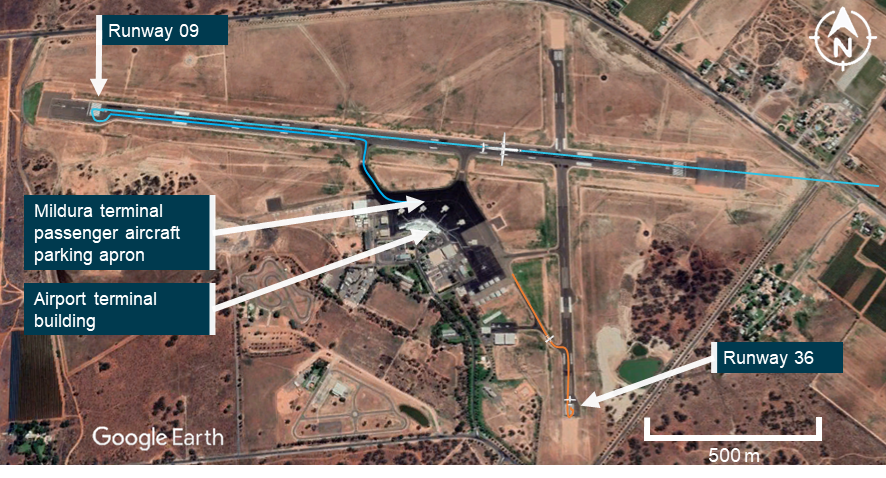A Dash 8 airliner began its take-off roll while its flight crew was unaware of another aircraft about to depart from a cross runway, highlighting limitations with the use of Dash 8 radio systems for ground‑based traffic communication at non-controlled airports.
The ATSB has released a final report from its investigation into the 29 September 2023 incident, in which a QantasLink Dash 8 taxied to the threshold of runway 09 at Mildura Airport, in Victoria, for a passenger flight to Melbourne.
At about the same time, a four-seat Lancair light aircraft was taxiing to the threshold of the intersecting runway 36 for an intended take‑off.

Both aircraft had made taxiing, entering, and backtracking calls on the Mildura common traffic advisory frequency, but neither was aware of the other until the Lancair broadcast a rolling (take‑off) call after the Dash 8 had made a rolling call and had begun its take‑off.
The Dash 8 had already passed the take‑off decision point when its crew heard the Lancair's rolling call, and in response the Dash 8 first officer immediately responded with 'aircraft rolling 36, hold'.
Believing that the Dash 8 crew's call may not have been heard by the Lancair, the pilot of a third aircraft relayed to the Lancair that there was another aircraft rolling on runway 09. Having not yet begun to roll, the Lancair pilot acknowledged and aborted their take‑off. The Lancair remained at the threshold about 730 m from the runway intersection as the Dash 8, taking off on runway 09, crossed runway 36.
"The ATSB's investigation sought to determine why the pilots of both aircraft had not heard radio calls from the other aircraft," ATSB Chief Commissioner Angus Mitchell explained.
"One call was partially over‑transmitted, and the Dash 8 crew was actively arranging separation with other aircraft in the air at the time of their departure. But more significantly the investigation identified limitations in the strength and readability of the Dash 8's VHF radios on the ground."
The investigation established that there was reduced radio reception and transmission strength towards the rear of the Dash 8 when on the ground, affecting radio call readability to and from other ground‑based airfield users.
Additionally, the ATSB found that ground‑based transmission and reception on the aircraft's VHF COM 2, which has an antenna on the aircraft's underbelly, had reduced strength and clarity. Dash 8 series aircraft have two VHF radio systems: VHF COM 1, which has its antenna on the roof, and VHF COM 2.
"The ATSB conducted rigorous testing at Mildura, in conjunction with the Australian Communications and Media Authority, Mildura Airport, and QantasLink, which provided a Dash 8 for testing," Mr Mitchell said.
"This allowed investigators to conclude that ground‑based transmissions on VHF COM 2 had reduced strength and clarity."
As per procedures, QantasLink Dash 8 flight crews used VHF COM 2 for ground calls at non‑controlled aerodromes such as Mildura.
"This likely led to the Lancair having difficulty receiving and understanding radio transmissions from the Dash 8, and the Dash 8 not receiving other transmissions," Mr Mitchell said.
The investigation also established that De Havilland Aircraft of Canada Limited - the type certificate holder for the Dash 8 - had not published guidance to operators on transmission and reception limitations of VHF COM 2 radios for ground‑based communications.
De Havilland Aircraft of Canada Limited has subsequently issued two flight operations service letters to all Dash 8 operators relating to the transmission and reception performance limitations of VHF COM 2 radios for ground‑based communications.
The ATSB is also releasing a safety advisory notice to Dash 8 operators to highlight this issue.
"We're asking all Dash 8 operators and crews to consider the use of VHF COM 1 radios, which uses the roof antenna, for ground‑based communication while operating at non‑controlled aerodromes, to improve radio transmission and reception with other nearby stations," Mr Mitchell said.
At Mildura Airport, aircraft are not directly visible to each other on the thresholds of runways 09, 27 and 36 due to topography and buildings. The ATSB found that, although not a factor on this occasion, the lack of a requirement for mandatory rolling calls increased the risk of aircraft not being aware of each other immediately prior to take‑off.
In response to this incident, and a related earlier incident in 2023 investigated by the ATSB, Mildura Airport now requires that radio calls be made by pilots commencing take‑off at Mildura.
QantasLink now requires crews to use VHF COM 1 radio for ground‑based departure communications at Mildura, improving ground‑to‑ground radio communication, mitigating collision risks presented by the cross‑runway layout and communication difficulties between runways.
"The ATSB welcomes changes made to the radio procedures at Mildura, but also notes that other aerodromes in the country may be subject to similar interference issues and consideration of expanding the Mildura Dash 8 operational procedures may be warranted," Mr Mitchell concluded.
You can find here the final report: Aircraft separation issue during take-off involving Lancair, VH-VKP, and De Havilland Aircraft of Canada Limited DHC-8-315, VH-TQZ, Mildura Airport, Victoria, on 29 September 2023
You can find here the Safety Advisory Notice: Dash 8 reduced ground-based communications quality on VHF COM 2






